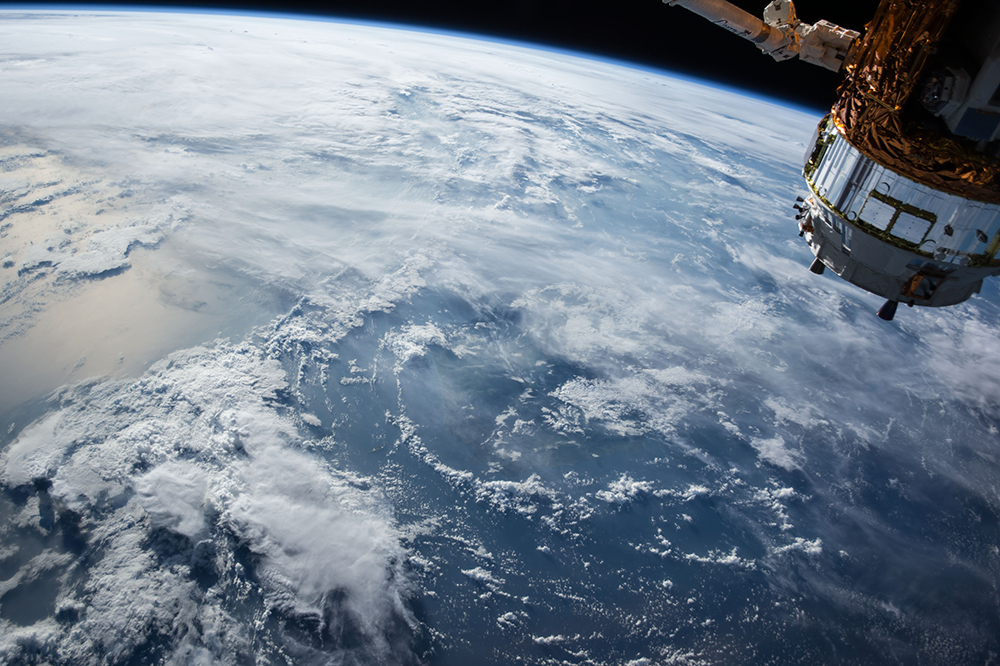
40 with 31 posters participating
- Three new instruments will build upon groundbreaking work by the Solar Dynamics Observatory, shown here. This gallery contains some highlights.
- A good-sized coronal hole at a slanted angle is nearly centered on the face of the sun in late 2018. Coronal holes are magnetically open areas from which solar wind particles speed into space.
- NASA’s Solar Dynamics Observatory scientists use computer models to generate a view of the sun’s magnetic field. Here is an extreme ultraviolet view of the Sun with the same image showing the superimposed field lines. The bright active region right at the central area of the sun clearly shows a concentration of field lines, as well as the small active region at the sun’s right edge, but to a lesser extent. Magnetism drives the dynamic activity near the sun’s surface.
- On Nov. 7, 2018 for just under an hour, SDO viewed a lunar transit, when the Moon partially blocked SDO’s view of the Sun. At its peak about 44% of the Sun was covered.
- The lone active region visible in April, 2018, on the sun put on a fine display with its tangled magnetic field lines swaying and twisting above it when viewed in a wavelength of extreme ultraviolet light.
- A good-sized active region with bright, towering arches began to rotate into view in April, 2018.
- For the first time in a long time the Sun has gone an entire month without any sunspots (Feb. 1-18, 2019). To put this in context, for five years (2011-2015) surrounding the latest solar maximum in March 2014 – the period when the Sun’s magnetic activity is the most intense – there were only three days without any sunspots.
- Coronal holes appear dark in certain wavelengths of extreme ultraviolet light like the one here. They are areas of open magnetic fields from which solar wind rushes out into space.
- A small prominence hovered above the sun’s surface over a two-day period in June, 2018, before breaking off into space. Prominences are cooler, darker clouds of plasma tethered above the sun by magnetic forces. These clouds of gases are notoriously unstable.
- NASA’s Solar Dynamics Observatory ran together three sequences of the sun taken in three different extreme ultraviolet wavelengths in March, 2018. In the red sequence (304 Angstroms), we can see very small spicules and some small prominences at the sun’s edge, which are not easy to see in the other two sequences. In the second clip (193 Angstroms), we can readily observe the large and dark coronal hole, though it is difficult to make out in the others. In the third clip (171 wavelengths), we can see strands of plasma waving above the surface,
The Sun is our closest star, and without it life on our world could not survive. So it is essential to understand its nature. And yet, even though the Sun shines brightly on every clear day on Earth, it is difficult for astronomers to observe the star closely for a number of reasons.
Most obviously, it is hotso hot, it is difficult to get too close without getting burnt to a crisp. Additionally, due to high solar gravity, it requires a lot of energy to insert a spacecraft into an orbit near the Sun. The harsh radiation near the Sun also plays havoc with the scientific instruments on spacecraft.
For all of these reasons, while astronomers have made steady progress in understanding the Sun and its effects on Earth, our atmosphere, and other bodies in the Solar System, we still have big questions. The good news is that we are now entering the golden age of Solar research with a major new ground-based telescope and two space-based observatories that will come close to the Sun.
“There is no doubt that the observations and insight will be unprecedentedexploring new regions with new instruments in incredible detail,” David Alexander, a solar physicist at Rice University and director of its space institute, told Ars.
First light in Hawaii
You may have seen the amazing images recently released by the Daniel K. Inouye Solar Telescope, which is located on a mountaintop at 3,084 meters in Maui, Hawaii. With a 4-meter aperture, it is the world’s largest solar telescope. The new images were part of the first test observations, with routine science observations set to begin this summer.
Images and video of the Sun from the telescope showcase features as small as 30km, the best resolution ever observed. Cell-like structures about the size of Texasthey also look like popcorn, or small nuggets of goldboil across the Sun’s surface, bringing heat from the interior of the star to the surface. This hot plasma then cools slightly and sinks back below the surface of the Sun. It is all rather mesmerizing.
- In this picture taken at 789nm, we can see features as small as 30km (18 miles) in size for the first time ever.
- In these dark lanes we can also see the tiny, bright markers of magnetic fields. Never before seen to this clarity, these bright specks are thought to channel energy up into the outer layers of the solar atmosphere called the corona.
- The NSFs Inouye Solar Telescope images the sun in more detail than weve ever seen before. The telescope can image a region of the Sun 38,000km wide.
This telescope also has scientific instruments that will allow it to measure the magnetic field in the solar corona in great detail. This will help scientists understand more fully how the energy in the Suns magnetic field gets released to heat the corona, and drive flares and coronal mass ejections, Alexander said.
New probes
NASA’s Parker Solar Probe launched on a Delta IV Heavy rocket in 2018, and will eventually pass as close as close to the Sun’s surface as seven times the star’s radius. This probe has already provided a wealth of new science data, bringing insight into the solar wind, and will only yield more as it spirals closer to the Sun.
As early as Sunday night, February 9, the Solar Orbiter built by NASA and the European Space Agency will also launch on an Atlas V vehicle. This spacecraft will not go nearly so close to the Sun as the Parker Solar Probe, but it will reach the orbit of Mercury in terms of proximity and leave the ecliptic to provide scientists with by far their best look at the Sun’s poles. (The Ulysses spacecraft, launched in 1990, had a polar orbit but at distances of about 2 to about 5 times Earth’s distance from the Sun, and it only possessed a suite of in-situ instruments with no camera).
These new probes will build upon astronomers’ existing information about the Sun. Already, this body of knowledge has grown considerably over the last decade thanks to instruments such as the Solar Dynamics Observatory, which is in geostationary orbit around the Earth and has provided a great amount of high resolution imaging data. With the three new scientific tools, we are about to have a much more complete view of our Sun as a star, which matters not only for us, but also as we look to worlds around other stars.
“Over the course of the next 5 to 10 years we will have a much deeper understanding of the Sun as a star, which can have a significant impact on our understanding of exoplanet environments and as a consequence improve our understanding of what makes a planet habitable,” Alexander said.




More Stories
After a cluster of new COVID-19 cases among the White House staff and a campaign offical, the election night watch party in the White House has become another symbol of U.S. President Donald Trump’s cavalier attitude toward a virus that is ripping across the …
Rob Lucas says the SA economy is forecast to go backwards by 0.75pc in 2020-21, a better outcome than a national economy forecast to shrink 1.5pc.
Labor and crossbench senators want changes to JobMaker, arguing too many workers will be excluded from the hiring credit scheme.